The challenge described here has had a number of attackers and contributors since it was first posed to a wide audience around early 2009.
The current page was posted 2013/04/04 by Russell Jones (SadisticMystic), with significant contributions and support from Kaitlyn Burnell (metroid composite), whose explanation about a predecessor to this combo is still preserved here. Magic: the Gathering is a registered trademark of Wizards of the Coast, a subsidiary of Hasbro, Inc.
Your mission, should you choose to accept it...
- Start with a Vintage-legal Magic deck of exactly 60 cards. Certainly no less, of course, and if going over 60 was allowed then this challenge would simply devolve into an extremely inelegant mission to fill the deck up with as many dummy cards as you could possibly get your hands on. No cards may be brought in from outside the game either--once you count to 60, that's all you get.
- Take the first turn of the game, using any 7-card hand you like. (Or fewer, if you have reason to take a mulligan. Amazingly enough, one of the ideas I brought up during brainstorming really did involve a mulligan, with a purpose behind it.)
- Conditions caused by randomness can be resolved in the most favorable manner you like. Even beyond the opening hand, if you can draw or otherwise utilize more cards on the first turn, those can be in any order you like. Additionally, you can win any coin flips that might come up. It's an all-out Magical Christmasland scenario: as long as there is some nonzero probability of your actions playing out, make the most of it! Just beware of the "nonzero" term. For example, if you put a card on the bottom of a non-empty library and then draw a card without using a shuffle effect first, it's guaranteed not to be the same card you just put back. (It might, however, be a duplicate copy of the card, as long as you keep the other rules about deck construction in mind.)
- The opponent is a goldfish, and will provide no interference of their own volition. However, if you force the opponent's hand by using a card that requires them to make a decision, such as Trade Secrets, you'll have to assume their decision is the one that's more effective at preventing your goal. Sometimes this could end up being extremely complicated: in the case of Fact or Fiction, there are 16 possible ways to split it, and any analysis involving that card would have to involve going over all 16 and figuring out which one leaves you the worst off. In short, you probably don't want to use cards like that.
- Beyond that, all standard Magic rules apply, including conditions for ending the game. For example, if you have a setup that can deal 20 damage to target player a million times in a row, the game will end after the first such ability deals damage to the opponent (unless you take further countermeasures against that), and any subsequent "potential damage" may as well not exist. Be careful.
- With all those rules laid out, the goal of this exercise, and the metric on which results are judged, is to deal as much damage as you can to the opponent by the end of that first turn. Even if you can take an extra turn before your "opponent" would get one, only the first turn itself is under consideration, so those effects are useless.
- Of course, there is one more proviso that needs to be added such that this doesn't become trivial. There must be a definite, finite upper bound to the damage. If, for every integer N, a line of play exists that would allow your deck to deal at least N damage within the one-turn window, subject to the previous rules, then your deck is said to contain an unlimited loop (in other words, it "goes infinite"), and does not qualify for consideration here.
I know my description of the challenge at hand involves a lot of technical jargon, but it's not going to get much better from here on. In fact, it'll likely be a good deal worse, because there will be numbers working their way in too. Still, if you're the type of person who wonders about theoretical Magic constructs like this, and if you really do have an interest in keeping up with such wizardry, reading on will be right up your alley. There's not going to be any Tarmogoyf among the cards here...they don't bite.
In essence, this challenge is the analog of the busy beaver problem, but using Magic decks rather than Turing machines as the unit of computational complexity (although...speaking of Magic decks and Turing machines...)
So how much damage can you deal?
"Mountain, Spark Elemental, swing for 3!"
Seriously now, you can do better than that.
"Add three Mutagenic Growth and a Bounty of the Hunt to make it 12?"
NEXT!
"Lotus, Mox, Mox, Mox, Mox, Channel, Kaervek's Torch. Take 23."
You win! The game, that is. As for this challenge, you're still not even close.
"Exile Simian Spirit Guide and play Mana Clash..."
Sit down. Remember, this is Magical Christmasland, so no matter how much damage you want to deal, there's always the possibility that you flip only heads and the opponent flips only tails for more than that many flips, and indeed no guarantee will finish resolving in any finite amount of time.
"Black Lotus, Forest, Channel, Primal Surge. Flip up a deck of Concordant Crossroads, Intruder Alarm, 4 copies each of Priest of Titania/Elvish Archdruid/Wirewood Channeler/Seeker of Skybreak (plus Wellwisher since life turns into mana too), a Feral Animist to put all that mana to use, and...Djinn Illuminatus. There are still three cards in hand, including such goodies as Cackling Counterpart..."
Now you're on the right track. Doubling is such an efficient operation.
Still, that leaves plenty of cards unutilized. If you added a Gaea's Cradle to the surge, you'd be able to get a similar use from cards like Argothian Elder, but that's quite a minor change compared to the power this combo already has. It's still the same fundamental sequence of events, and the damage output achieved by Feral Animist would hardly even budge: it's still only about 2^(27 septillion). That may be far more damage than you need to win a game of Magic, but you can still do better than that.
On a more basic level, a problem with Djinn Illuminatus is you have to commit to a number of replicates before any of them resolve, and pay them all up front, even though the subsequent resolutions of the spell will fuel a lot of mana production. It would be much more convenient if you could make copies of things on demand with something like Kiki-Jiki, Mirror Breaker. Of course you'd have to change things around to do that, as Kiki-Jiki would go infinite in the presence of either Intruder Alarm or Seeker of Skybreak. So sometimes using less powerful cards can end up better for the combo in the long run, because it means you have room for more cards that feed off each other without reaching that critical mass of power that lets you spiral off into the boundless realms (Not the Magic 2013 One).
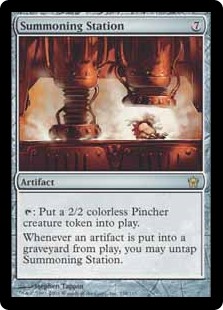
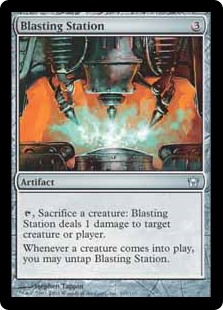

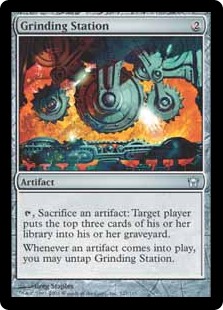
Now that's some feeding. Too much so, in fact.
And Now, Our Feature Presentation
The current decklist for our attempt at this challenge is here, in convenient .dec form if you should ever want to play it. And you almost certainly don't. Seriously, 3 lands (one of which doesn't even produce mana), cards of all 5 colors, an average converted mana cost of almost 4, so many seemingly random cards that do almost nothing outside the contrived circumstances we've created for them here, and an extremely narrow tightrope that has to be walked to get it all started. Needless to say, outside of the Magical Chrismasland rules allowed by this scenario, it'll have a devil of a time getting anything done at all.
And yet...it stakes out a higher claim for turn-1 damage, which is the question at hand, than any other possible deck the authors are aware of. It truly exemplifies the practice of each card in turn being used to fuel the one before it (but not the one after it, or else it could go infinite--this means that each engine piece in turn will carve out a bit more space that's disallowed to subsequent cards, kind of like creating a minefield, but the explosions are much bigger). The engine has enough different sections, plus assistive cards that serve to maximise the work each section is capable of, that the 60-card limit is stuffed to the gills.
The basis of the whole thing is the interaction between Doubling Season and Minion Reflector. If you have X copies of one, Y copies of the other, effects that turn both of them into creatures (since that's what Minion Reflector triggers on), and an adequate source of mana to cover all payments demanded by all Minion Reflector copies, then playing either one of those permanents will raise its quantity beyond the greater of X or Y...no matter what those numbers are. For best results, playing them in alternation will cause both their ranks to lift each other up, at an exponential rate each time. All that's left is to see that "each time" is talking about a lot of times, and that's what the other 58 cards are for. How do they do it? That's what the rest of this page is going to explain.
Onward we go.
Section 0 (Getting Started)
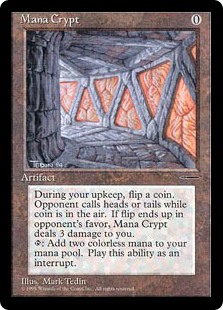
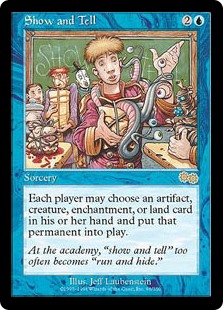

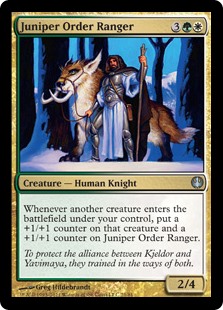
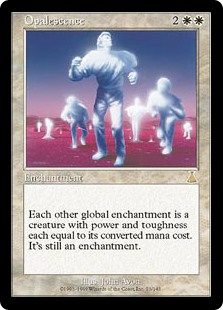
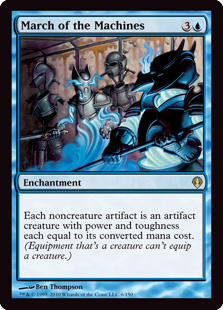
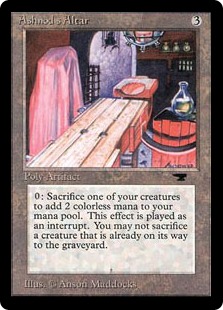

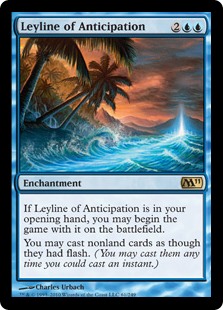
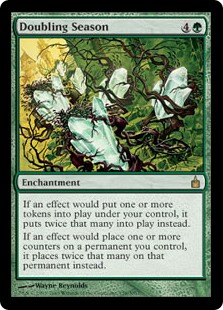
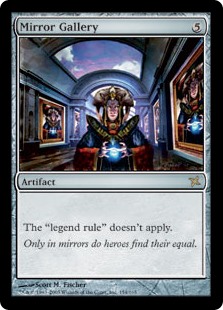

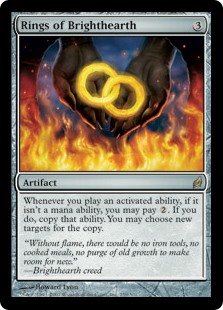
Begin by playing Snow-Covered Island and Mana Crypt. Why is the island snow-covered? No particular reason. It's just funnier that way.
With the 2U you can now produce, play Show and Tell and use it to drop Omniscience. Three cards remain in hand, and 53 in library.
From here, it would seem like the easiest way to draw all the cards is simply by playing Enter the Infinite (or, given that coinflips always work, Squee's Revenge). Squee's Revenge ends up unacceptable because of other considerations later on, but more importantly, this combo is so complicated and stringent that there is simply no room to add Enter the Infinite, because of the 60-card maximum. We'll have to take a more convoluted path, strange as that sounds.
Start that path by playing Juniper Order Ranger, then Body of Jukai (after all, Omniscience makes all spells from your hand free...why bother paying 5 or 9?) Body of Jukai becomes 9/6 (and Juniper Order Ranger becomes 3/5 but we don't care about that), which means playing the last card in your hand, Twisted Justice, gives back 9 cards after sacrificing the Body. It may not be a full-deck draw like the other two cards that got passed over, but it's a good enough start for now. 44 cards remain in the library. Body of Jukai has a soulshift trigger, but it does nothing except set off a bit of foreshadowing.
Now that you have a newly-refreshed hand, play out some more cards: Opalescence, March of the Machines, and Ashnod's Altar. 6 cards left in hand, and Mana Crypt will be forcefully killed off as a 0/0 creature without allowing an opportunity to sacrifice it for mana.
Since artifacts and enchantments are now animated, play Minion Reflector, which will trigger for itself. Sacrifice Juniper Order Ranger to Ashnod's Altar for the requisite 2 mana, getting a second copy of Minion Reflector.
Next up, play Leyline of Anticipation, which causes both Minion Reflectors to trigger, and more importantly, gives all your spells flash. This allows you to respond to the triggers, so play Doubling Season, getting 2 more triggers. Play Mirror Gallery in response to that, so now there are 6 triggers on the stack which haven't been paid for yet. Sacrifice Mirror Gallery to Ashnod's Altar to pay for its own first trigger, and Doubling Season causes the trigger to give back 2 Mirror Gallery tokens. Sacrifice one of those tokens right away to pay for the second trigger, so now there are 3 Mirror Gallery tokens.
Conveniently, 3 is just enough that you can sacrifice two of them for mana, paying for the triggers on Doubling Season, and still have one left: don't ever lose this last copy, or else Bad Stuff will happen. The first trigger gives 2 more token copies of Doubling Season, and then since there are now 3 of them, the second trigger's token will be doubled 3 times to produce 8 more tokens, for a total of 11.
Finally, time to get to Leyline's triggers. Sacrifice Leyline for its own payment, briefly losing the flash capability for a while before getting it back 2048-fold. Another token sacrifice will get back 2048 more, so there are 4095 copies of Leyline, and the stack is clear. 2 cards remain in hand.
Play Mirari, which will again have 2 Minion Reflector triggers go off for it. Thanks to Mirror Gallery, no ill effects will be produced when those triggers produce additional copies of it. Sacrifice two Leyline tokens, dropping to an absolute pittance: 4093 (hey, that number will seem like a pittance by the time we're done), and 4097 Miraris.
Play the final card: Reborn Hope. There are two multicolor cards in the graveyard right now, Twisted Justice and Juniper Order Ranger. Target whichever one you want, since the spell won't be resolving anyway. 4097 Mirari triggers go on top of it, and each one wants a payment of 3 mana. Fortunately, you only have to pay for one at a time. Sacrifice two Leyline tokens, getting 4 mana so you can pay for the first Mirari with 1 to spare. Get a copy of Reborn Hope that returns Juniper Order Ranger, and this is why the original spell will fizzle: the copy plucked one of its potential targets out from under it, and the remaining 4096 Mirari copies will eventually do the same for the other possible target. But it's not time to deal with those yet.
(Point of clarity: In fact, it's actually slightly more efficient to skip out on Juniper Order Ranger entirely, and have even the first Reborn Hope copy get back Twisted Justice. This draws just a few cards at a time in the Ranger's absence, but it's enough to build the combo up piecewise until it's all up and running, and eventually the Ranger can be brought back by other means. However, that causes most of the following sections to look much different than they'll be after getting up to speed, and in any case it would be much harder to follow along with. By explaining it as though a copy of Reborn Hope returns the Ranger, you can think of it as a shortcut into the mainline loop, which ultimately causes only a negligible loss in the long run.)
Leyline of Anticipation proves its worth again, as you can replay Juniper Order Ranger before any of the other Mirari triggers resolve; otherwise they would have nothing to do. Sacrifice two more Leyline tokens (to speak of proving their worth) to pay for Minion Reflector and get 4097 copies of that. They'll all trigger back and forth on each other, and get millions of +1/+1 counters each. If you wanted, you could clear the stack without paying for anything, then attack for over 25 billion damage right now. But that would suck, so don't do that.
Now you can sacrifice another Leyline token (only 4088 left!) for 2 more mana, to go with the 1 that's still floating. Let the second Mirari trigger resolve, this time returning Twisted Justice to your hand, then immediately replay Twisted Justice targeting yourself. Of course, Mirari also triggers on this, putting 4097 more things on the stack. Two MORE token sacrifices will pay for the first Mirari trigger, and when the Twisted Justice copy resolves, sacrifice yet another Leyline token. The first Twisted Justice was good for 9 cards; the second one for only 4 (sadly, sacrificing a Juniper Order Ranger to draw several million cards would be suicidal). But those 4 cards will allow us to bring the entire rest of the deck into the fold, and remember there are still 4097 more copies of Twisted Justice before even reaching the 3rd Mirari trigger for Reborn Hope. Other than the next Twisted Justice, none of those spells or triggers are going to resolve for a long, long time. 40 cards remain in the library.
One more thing: play Rings of Brighthearth, getting 4097 copies of it as is customary by now, and at this point the main sequence of iterative loops is all set up.
Section 1
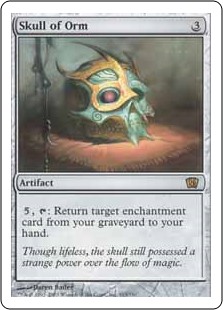
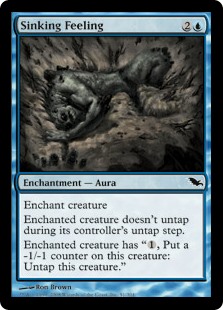
Play Skull of Orm. This seemingly-overcosted card is the one that really sets the dominoes in motion. First of all, both Minion Reflectors trigger, but for now you only want one trigger to resolve, and you can pay for that trigger by sacrificing Skull of Orm itself. This is because Skull of Orm doesn't have haste (See? Animating artifacts isn't all sunshine and rainbows...), but the copies produced by Minion Reflector do, so those are the ones that will have to do all the heavy lifting. Get 2048 Skull of Orm tokens, and order the Juniper Order Ranger triggers as follows:
- (top of stack)
- Ranger 1, Skull 1
- Ranger 2, Skull 1
- Ranger 3, Skull 1
- ...
- Ranger 4097, Skull 1
- Ranger 1, Skull 2
- ...
- Ranger 4097, Skull 2
Ranger 1, Skull 3
- ...
- Ranger 4097, Skull 2048
- (remainder of stack)
- trigger from Minion Reflector 2
- Reborn Hope (with no legal target anymore), Twisted Justice, and their respective Mirari triggers
- (bottom of stack)
But don't even let the topmost trigger resolve yet. Instead, there's still 1 floating mana from paying for Mirari a third time. Sacrifice another Leyline token along with the non-token Doubling Season to get to a total of 5, and then activate Skull of Orm targeting the Leyline in the grave. (Obviously you don't really care very much about having it back, but this is the original activation and it would fizzle otherwise, so you might as well make it good for something, however minor it may be.) 4097 Rings of Brighthearth trigger from this, and that's going to be a recurring setup from now on, so it's worth getting accustomed to.
Sacrifice another Leyline token to pay for the first Rings of Brighthearth trigger. This time, of course, the copy can target Doubling Season, so that returns to hand and you can immediately replay it. (Remember, you don't choose a target for a copy of a spell or ability until that copy is actually created, so the remainder of the copies will be able to target Doubling Season as well. There are currently no other copies of Skull of Orm's ability on the stack, just a bunch of triggered abilities from Rings of Brighthearth that will each create a copy when they resolve.) 2 Minion Reflectors trigger once again, and you can spare 2 more Leyline tokens to pay for them. The first ability sees 11 Doubling Seasons already around, and will produce 2048 more. The second one gets doubled 2059 times...
Yeah.
2^2059 is a number with 620 digits. At least that isn't too obstructive, taking up only a few lines of text, so here you go.
66,185,228,434,044,942,951,864,067,458,396,061,614,989,522,267,577,311,297,802,
947,435,570,493,724,401,440,549,267,868,490,798,926,773,634,494,383,968,047,143,
923,956,857,140,205,406,402,740,536,087,446,083,831,052,036,848,232,439,995,904,
404,992,798,007,514,718,326,043,410,570,379,830,870,463,780,085,260,619,444,417,
205,199,197,123,751,210,704,970,352,727,833,755,425,876,102,776,028,267,313,405,
809,429,548,880,554,782,040,765,277,562,828,362,884,238,325,465,448,520,348,307,
574,943,345,990,309,941,642,666,926,723,379,729,598,185,834,735,054,732,500,415,
409,883,868,361,423,159,913,770,812,218,772,711,901,772,249,553,153,402,287,759,
789,517,121,744,336,755,350,465,901,655,205,184,917,370,974,202,405,586,941,211,
065,395,540,765,567,663,193,297,173,367,254,230,313,612,244,182,941,999,500,402,
388,195,450,053,080,383,488
That is a lot of Doubling Seasons. If only the combo was anywhere close to finishing...but it's not. Anyway, wave goodbye to the big number, because it's the last time the numbers involved in the combo will be expressible in full like that.
After all, there's still a bunch of Rings of Brighthearth, and each one gives 2 triggers from Minion Reflector. The next replay of Doubling Season will raise 2 to a 620-digit power, and that's easily enough to blow past anything that could conceivably be stored in the known universe. With a slight loss of precision, we can call it 2^(2^2059), then the next one gives 2^(2^(2^2059)), and soon even that notation will get rather unwieldy as more and more 2's get added.
Fortunately, almost 40 years ago, a guy named Donald Knuth came up with an infinitely extensible solution to that mess. It's well established that all of the natural numbers can be built from a single base case (called "zero") and a "successor" operation: 1 is "the successor of 0", 2 is "the successor of the successor of 0", and so on. On top of that structure, the common operations are really just shortcuts for loops of the successor function, the ultimate recursive building block:
- a + b means "take the successor of the successor of... a, b times."
- a * b means "take a + a + ... + a, b times."
- a ^ b means "take a * a * ... * a, b times."
Naturally, there's no reason why you couldn't continue such a pattern for deeper and deeper layers of recursion, which are the main engine that drives larger and larger numbers here. After a while, you might have trouble coming up with distinct symbols for each layer, but Knuth's idea was to simply use multiple up arrows, or carets, to represent further nesting: "a ^^ b" means "a ^ (a ^ ... (a ^ a) ...), b times.", and so on for 3, 4, and more arrows. Obviously those numbers get very big, very fast. Let's look at the first few values of 2^^b.
- 2 ^^ 1 has just one 2, so it's 2.
- 2 ^^ 2 is the same as 2^2, and also 2*2 and 2+2 before it. Of course that's 4, and in fact 2^^^2, 2^^^^2, and so on are all equal to 4 as well.
- 2 ^^ 3 is 2^(2^2), so 2^4, or 16. Still pretty reasonable
- 2 ^^ 4 just sticks a 2^ in front of the previous power, and 2^16 is 65,536. Not bad, and temporarily going up a level (but down a digit), 2 ^^^ 3 also ends up being 65536.
- 2 ^^ 5 is 2^65,536. This is a very big number, with almost 20,000 digits. For sanity's sake, I won't be printing it here. Predictably, adding to the 5 makes it even more outrageous.
Since our base-case operation for blowing up the numbers during this combo is "get a batch of token copies of Doubling Season" and that takes the form of a ^ b (or really, 2 ^ b), it makes sense to say that exponents are our first layer, rather than deferring to addition and multiplication in front of it. This conveniently also allows the number of layers, and the number of carets (or arrows) in the representation, to be equal.
Anyway, after resolving 2 Rings of Brighthearth triggers, there are 2^(2^(2^2059)) Doubling Seasons. 2059 is more than 2^^3, but less than 2^^4; for lack of any better precision I'll round down to avoid accidentally overestimating. 2^(2^(2^(2^^3))) is just 2^^6, and each subsequent 2 that gets put on the beginning is just an increase of 1 in the second number. 4095 Rings triggers plus the original Skull activation are yet to resolve, and each trigger means replaying Doubling Season twice (or however many Minion Reflectors exist, but that isn't increasing yet). When all those effects are done resolving, there will be about 2^^8196 copies (you'll also run out of Leylines to sacrifice in the mean time, so you might have to sacrifice the occasional Doubling Season, but losing a few thousand of those won't even make a dent in the huge supply). The original activation will return Leyline of Anticipation instead of Doubling Season, which is a free excuse to top up with 2^^8197 of those, mainly as more sacrifice fodder.
Right now the topmost thing on the stack is a Juniper Order Ranger trigger, which would put a bunch of counters on the tapped Skull of Orm. But it's still not time to let that resolve! The tapped Skull of Orm is a 3/3 creature, so play the next-to-last card from hand: Sinking Feeling. Fortunately, Doubling Season only doubles counters that are put on from effects, not costs, so you can pay the cost for Sinking Feeling and only get a single -1/-1 counter, leaving the Skull as 2/2. Get 4097 copies of the untap ability, and repeat the activation sequence again each time. When that's all done, you can still activate Sinking Feeling once more without killing Skull of Orm, so do that. This brings the number of Doubling Seasons to over 2^^67,000,000.
At last, it's time to let the first of the 8-million-plus Juniper Order Ranger triggers on Skull of Orm resolve (the Doubling Seasons won't end up sticking around in the long haul, so I've been ignoring triggers on those). Get about 2^^67,000,000 +1/+1 counters, and each counter is an opportunity to activate Sinking Feeling. 2^^67,000,000 is big enough, and from a sparse enough notation, that multiplying it by a "constant" factor like 4000 or 8000 doesn't really change the notation in any meaningful way, so this will produce about 2^^(2^^67,000,000) Doubling Seasons by the time it's all over...and since 67,000,000 lies between 2^^4 and 2^^5, we can estimate that as 2^^^6, again rounding down to avoid any possibility of staking a claim we aren't entitled to. Note the pickup of a third arrow, for a third layer of recursion.
Of course, keep this up for the remaining Juniper Order Ranger triggers. When you get through the last trigger for a given Skull, untap it by shrinking it to 1/1, activate it one last time (with Rings copies), and sacrifice it to Ashnod's Altar for mana. Sinking Feeling will then fall off, and you can use one of the Rings copies to target Sinking Feeling and return that, playing it on the next Skull in turn that's due to receive counters. This will increase the count to 2^^^(big number), but isn't enough to add a fourth layer of recursion yet.
There is, however, a second Minion Reflector trigger waiting to resolve. When it does, you get 2^^^(big number) more copies of Skull of Orm, and can repeat the process for each of those, which is sufficient to add a fourth layer of recursion. For this first time through the loop only, when you finally get to the last copy of Skull and the last set of +1/+1 counters, stop when it gets to 40 toughness instead of 1 (you lose 39 repetitions of a lower-level loop...big freaking deal). Then sacrifice that Skull to the next copy of Twisted Justice produced by Mirari, and you'll draw 40 cards, which is conveniently everything that's left in the deck, allowing you to set up many more sections and layers to build off of this.
Section 1 Summary
Input: One playing of Skull of Orm
Output: Lots of playings of Doubling Season
Layer count: For each Minion Reflector, for each Doubling Season on Minion Reflector's effect, for each Rings of Brighthearth on Skull of Orm, for each Doubling Season on Juniper Order Ranger's effect...4. Total 4.
Newly carved out space: Enchantments
Section 2
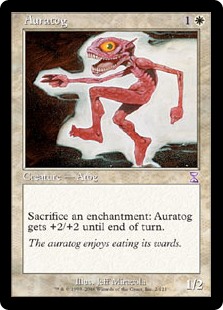
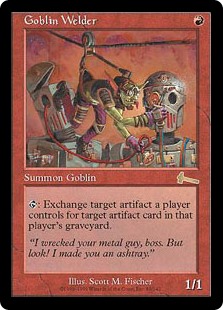
The first time you get to this section, play Auratog, which will come in handy (getting some tokens from Minion Reflector of course).
Next, play the real driving force here: Goblin Welder. Unlike Skull of Orm, you don't want to sacrifice the nontoken Welder here, for reasons that will be clear in section 3, but find some random piece of sacrifice fodder to get the payment kicked off and get lots of token Welders, all with haste. Activate it, and since the bottom-most activation is just a dummy, pick targets like the last remaning Mirror Gallery token, and the Mirror Gallery in the graveyard (which eventually provides more sacrifice fodder). Rings of Brighthearth will trigger from this, and in response to all that, sacrifice the nontoken Minion Reflector for mana. Use that mana to make a copy that exchanges a Mirari token for the Minion Reflector to get it right back, and Minion Reflector (along with any tokens on the board at the time) will trigger on itself to get a lot more tokens--more than there are Doubling Season. Use subsequent copies of the ability to exchange Minion Reflector and Skull of Orm back and forth; each time Skull comes back, perform all the steps in section 1 as far as possible before continuing (and when you get to section 3, it will involve looping through all of section 2 each time, and so on--that's what gives this combo so much explosive power, just as a ^ b builds on a * a, and a * b builds on a + a in turn).
When you get to the last Rings trigger from a given batch, sacrifice Rings itself for mana, then use a copy of the Welder ability to bring that back, so that the number of Rings keeps pace with the number of Doubling Seasons and Minion Reflectors, and when it comes time to activate Welder or Sinking Feeling again, you'll get even more copies of the ability.
In fact, because the number of Rings is constantly increasing from this section on, it gets to contribute two layers now: one for activating the Welder's ability itself, and one for the Sinking Feeling ability to untap Welder.
There's a bit of a snag, in that in order to repeat section 1, Sinking Feeling has to move on to Skull of Orm somehow. Sacrificing Goblin Welder would mean wasting all the potential untaps and +1/+1 counters, which completely defeats the purpose. You also can't sacrifice Sinking Feeling to Ashnod's Altar (Opalescence doesn't animate Auras, and for good reason, because by rule an Aura creature is immediately dead with no other questions asked). This is why Auratog is necessary: you can sacrifice Auras to that (preferably a token Auratog, which has haste and can actually get something out of the 2-power boost), then use a copy of the Skull ability in the first go-round to bring back Sinking Feeling and attach it to each Skull as necessary. When you get done with the section-1 loop, bring back Sinking Feeling and put it back on Welder, and continue to chip away at its health, 1 counter at a time, until you run out of counters, and eventually Welders.
Section 2 Summary
Input: One playing of Goblin Welder
Output: Lots of playings of Skull of Orm and Minion Reflector
Layer count: For each Minion Reflector, for each Doubling Season on Minion Reflector, for each Rings of Brighthearth on Goblin Welder, for each Doubling Season on Juniper Order Ranger, for each Rings of Brighthearth on Sinking Feeling...5. Total 9.
Newly carved out space: Artifacts
Section 3
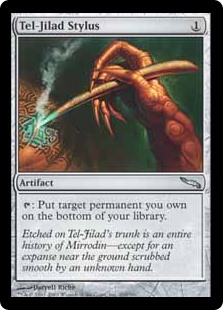

Again, this section needs to be kicked off with a setup card, this time Tel-Jilad Stylus. Get some Minion Reflector copies of it as usual. Tap one of the Stylus tokens to put the nontoken Goblin Welder back in the library, as the only card there. (Rings of Brighthearth will also trigger, but there's no reason to use those so just let them pass.)
Next, play Moggcatcher, getting copies as usual, and the routine should be obvious now: activate each one, copy the ability, bring out Goblin Welder each time, and repeat section 2. If you ever get low on untapped Tel-Jilad Styluses, the Welder can use an activation to bring that back for more; tapped Styluses are just sacrifice fodder anyway.
Section 3 Summary
Input: One playing of Moggcatcher
Output: Lots of playings of Goblin Welder
Layer count: For each Minion Reflector, for each Doubling Season on Minion Reflector, for each Rings of Brighthearth on Moggcatcher, for each Doubling Season on Juniper Order Ranger, for each Rings of Brighthearth on Sinking Feeling...5. Total 14.
Newly carved out space: Goblins
Section 4
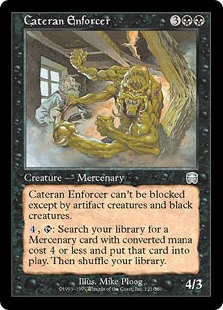
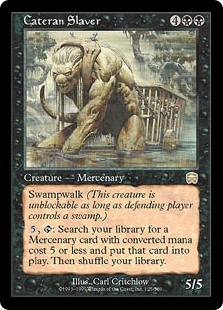

Moggcatcher was designed in Nemesis to be part of a three-card partial horizontal cycle with the aim of--and these are the words that Wizards themselves used to hype the cards--"giving blue, green, and red each a Rebel or Mercenary to call their own" by fetching a common creature type in that color. (More on that later...hint, hint.) Indeed, Moggcatcher is an actual Mercenary, which means that the more conventional, black mercenaries from Mercadian Masques can start a chain to fetch it. Moggcatcher itself costs 4, so there's a minimum threshold required to start the chain, but Cateran Enforcer costs 5 and fetches 4, Cateran Slaver costs 6 and fetches 5, and at the top of the chain, Cateran Overlord costs 7 and fetches 6. Essentially, this is just like three more copies of section 3 stuck end-to-end and feeding into each other, but with different cards filling in. It's a great way to fit a lot of layers into a compact space, which is invaluable given the limited deck size to work with.
Section 4 Summary
Input: One playing of Cateran Overlord
Output: Lots of playings of Cateran Slaver, and then even more in turn of Cateran Enforcer and Moggcatcher
Layer count: For each Minion Reflector, for each Doubling Season on Minion Reflector, for each Rings of Brighthearth on the Mercenary, for each Doubling Season on Juniper Order Ranger, for each Rings of Brighthearth on Sinking Feeling (repeated 3 times)...15. Total 29.
Newly carved out space: Mercenaries (with converted mana cost 6 or less)
Section 5
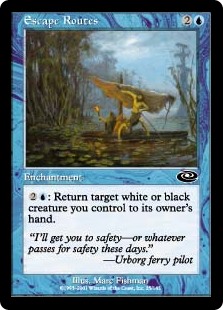
Play Escape Routes. Its ability doesn't require tapping, so multiple copies are redundant except for the purpose of having sacrifice fodder, but go ahead and get some tokens anyway because it only costs 2, and if nothing else, the copies can sacrifice for a lot more than 2 all together. Spend 2U to activate Escape Routes (targeting the nontoken Juniper Order Ranger; might as well), and copy it with Rings of Brighthearth...
Hold on, we don't actually have any blue mana yet. The only Snow-Covered Island is tapped. The first time through, there will be no loops in section 5 (or 6 or 7 for that matter), but in subsequent visits to this section (when the number will be unimaginably bigger anyway, so we're not missing out on much) it'll pull its weight. Not quite as much as the previous sections, since it isn't as simple as "tap a permanent for some effect and use an ability to untap it a lot," but Cateran Overlord needs to come back somehow. Each copy of the ability returns the nontoken Overlord, at which point you simply replay it to get more copies.
Section 5 Summary
Input: One blue mana (plus some colorless, which is in plentiful supply thanks to Ashnod's Altar)
Output: Lots of playings of Cateran Overlord
Layer count: For each Rings of Brighthearth...1. Total 30.
Newly carved out space: White creatures (eh eh eh-eh-eh?); black creatures (doo doo doo doo?)
Section 6
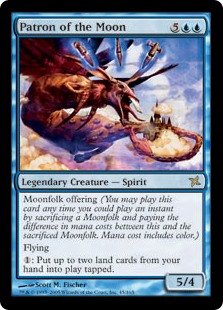

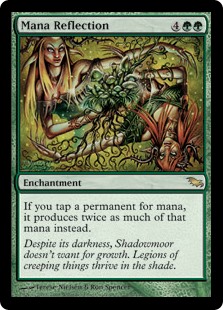
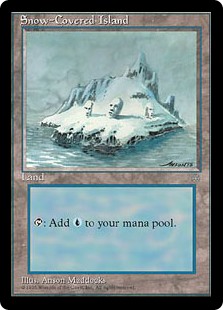
Start this off by playing Patron of the Moon, Nature's Revolt, and Mana Reflection.
Since you already played the Snow-Covered Island at the very beginning as your land for the turn, you can't just play more lands, but that's what the Patron is for. For 1 mana, you can dump any land from your hand onto the battlefield (or two lands, but amazingly enough, in this deck it's better to go just one at a time!) The land(s) will be tapped, which isn't an issue because Nature's Revolt makes them creatures and thus they have summoning sickness anyway, while the copies produced by Minion Reflector (which only exist because they're animated) start out untapped and ready to go.
Anyway, get the Island back down, and get some Minion Reflector copies. Tap one Island for lots of blue mana thanks to Mana Reflection, and while Rings of Brighthearth doesn't work on that (since it's a mana ability), it does work when you drop Sinking Feeling onto the land and start untapping it. When you get to the very last section-1 replay before each tap of the land, make sure to use the final Skull of Orm activation to bring back Mana Reflection, allowing its numbers to top up along with everything else, so the next land tap will give enough mana to contribute to a higher layer.
Again, the Snow-Covered Island is currently (on the first loop through) both tapped and on the battlefield, so Patron of the Moon can't do anything with it yet.
Section 6 Summary
Input: One playing of Snow-Covered Island
Output: Lots of blue mana
Layer count: For each Minion Reflector, for each Doubling Season on Minion Reflector, for each Mana Reflection on the mana ability, for each Doubling Season on Juniper Order Ranger, for each Rings of Brighthearth on Sinking Feeling...5. Total 35.
Newly carved out space: Blue mana sinks
Section 7
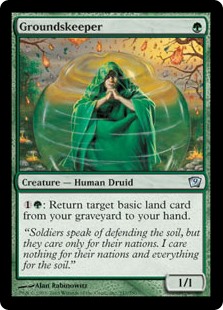
Play Groundskeeper here. Like Escape Routes, it's a non-tapping ability, and the Minion Reflector copies are just sacrifice fodder again. Sacrifice the nontoken Snow-Covered Island for mana, then Groundskeeper can activate its ability targeting that. By sacrificing the land after each loop here, it'll be back in the grave to be targeted by the next copy from Rings of Brighthearth once that copy is created, and this is surely standard fare by now.
Except...Groundskeeper's ability costs 1G. We didn't have any blue mana going through for the first time, and we have no green either. Oh well, at least we're about to make up for lost time soon.
Section 7 Summary
Input: One green mana (plus colorless)
Output: Lots of playings of Snow-Covered Island
Layer count: For each Rings of Brighthearth...1. Total 36.
Newly carved out space: Basic lands
Section 8
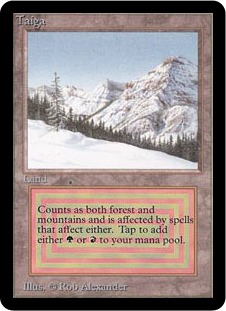
Use Patron of the Moon to dump Taiga from hand (by the way, Rings of Brighthearth on Patron's ability is just a huge waste of time; it costs 2 to make a copy with Rings, when you could just activate the ability again for 1 mana anyway, and you don't even need more than one activation at a time). For a shocking change, Taiga actually happens to be where we need it to at the start of all this! So drop it, and start scooping up the previous few sections at last. And do it a lot. Because there's certainly a lot of green mana to be made right now, and future visits to this section are only going to make more.
Section 8 Summary
Input: One playing of Taiga
Output: Lots of green mana
Layer count: For each Minion Reflector, for each Doubling Season on Minion Reflector, for each Mana Reflection on the mana ability, for each Doubling Season on Juniper Order Ranger, for each Rings of Brighthearth on Sinking Feeling...5. Total 41.
Newly carved out space: Green mana sinks; red mana sinks
Section 9
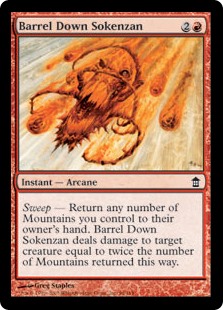
Play Barrel Down Sokenzan, getting a bunch of Mirari triggers (side note: right as you get to this section, make sure to use one of the Goblin Welder activations at the end of the section 2 loop to recycle the nontoken Mirari, so you can top up on copies of that). Note that Sweep is not an additional cost, but a choice made on resolution, so each copy lets you sweep up the Taiga, putting it where Patron of the Moon can conveniently put it right back.
Also, each copy should target a Juniper Order Ranger as the damage recipient. The Rangers get bigger with each new creature during each loop section, easily offsetting the 2 damage they'll receive from each copy of the spell. They won't be able to attack in the end, but for now the Rangers are a convenient target that's guaranteed to stick around in the short term and not cause any accidental fizzling, not even for the original copy of the spell.
Section 9 Summary
Input: One playing of Barrel Down Sokenzan
Output: Lots of playings of Taiga
Layer count: For each Mirari...1. Total 42.
Newly carved out space: Mountains
Section 10

The defining feature about Barrel Down Sokenzan, at least when it comes to distinguishing it from the other cards in the deck, is it's an Arcane spell. So play Hana Kami, get some tokens, and then instead of emptying the pool of all the green you got from the last section 8 loop, leave one green mana unspent, because you need that to activate Hana Kami (of course, you also need to sacrifice the Kami here, and that's the bottleneck in this step). Barrel Down Sokenzan is the only Arcane spell in the deck, so the original activation can't help but fizzle, as each copy of the Kami's ability picks it back up (almost like sweeping).
There were several other possibilities to consider for the Arcane slot: Blind with Anger, Psychic Puppetry, Toils of Night and Day, Cut the Earthly Bond, Goryo's Vengeance, and of course the other sweep spells Sink into Takenuma and Charge Across the Araba all potentially have merit depending on what cards you surround them with.
In our case, some of those cards simply go infinite, and Barrel Down Sokenzan ultimately got the nod because of the nice set of bottlenecks that could fit into the deck with Taiga. Just some of the things to look out for should you ever decide to construct a similarly-sized combo. Maybe if there are enough additional pieces, it might make sense to go after a Commander deckbuilding restriction one day. The deck is already singleton, and having 39-40 extra cards of room can only help.
Section 10 Summary
Input: One playing of Hana Kami (and some green and colorless mana which is already in plentiful supply below this point)
Output: Lots of playings of Barrel Down Sokenzan
Layer count: For each Minion Reflector, for each Doubling Season on Minion Reflector, for each Rings of Brighthearth on Hana Kami...3. Total 45.
Newly carved out space: Arcane spells
Section 11
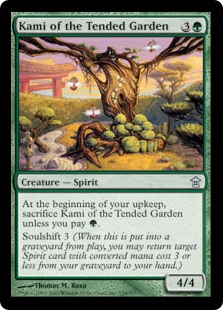
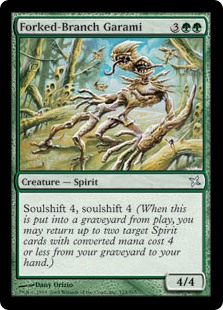
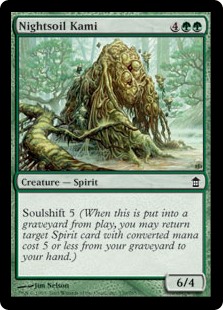
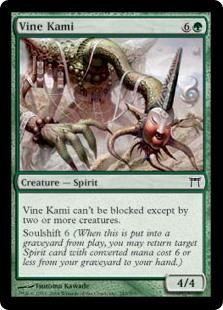
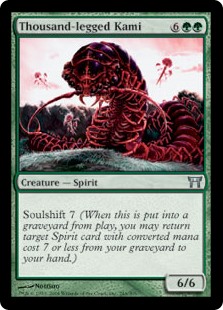

Kamigawa had a strong theme of Spirits and Arcane spells working together, essentially the predecessor of the Tribal card type. Hana Kami is a Spirit, and it brings back Arcane spells. There was another mechanic in the same block, whereby Spirits brought back other Spirits: Soulshift.
Play Kami of the Tended Garden, and when you get each batch of Minion Reflector tokens, sacrifice them one at a time, triggering soulshift and getting Hana Kami back into your hand, leading smoothly back into section 10. Kami of the Tended Garden only has soulshift 3, and it costs 4, so it's unable to bring itself back (all the Soulshift creatures were structured that way except Promised Kannushi, which isn't actually a Spirit itself, and Kodama of the Center Tree which is obviously unusable with so many tokens running around).
The rest plays out similarly to the Mercenary chain, but using triggered abilities rather than activated abilities. Forked-Branch Garami has two instances of soulshift, so it can bring back Hana Kami and then Kami of the Tended Garden both (yes, it would be legal to choose the same target for both abilities, and they do resolve separately, but that would just make the other one fizzle). Then Nightsoil Kami has soulshift 5, Vine Kami has soulshift 6, Thousand-Legged Kami has soulshift 7, and Body of Jukai caps it off with soulshift 8.
Humorously, soulshift 8 is enough to bring back Patron of the Moon, but that's merely a support card which doesn't benefit much from backup copies, and doing so would just be a waste of time and resources, compared to playing down the soulshift chain normally. Maybe if there was a Rings of Brighthearth lookalike for triggered abilities (and if it was extremely careful in its wording, as it would have to be), you could use that fact for a minor "might as well" gain on the original trigger. I'm not holding my breath for a card like that to be printed.
Yes, Hana Kami only costs 1 mana, and there are soulshift 1 and 2 cards, but a strange case of circumstance and small sample size forces the chain to start up at 3. In the case of soulshift 1, the only possible choice is Deathknell Kami, which is a black creature. That means Escape Routes could bounce it, forming an unacceptable upward branch from section 5 and allowing it to go infinite.
Soulshift 2 is slightly more populous, with 2 creatures: Thief of Hope (which is not only a black creature, but it has a mandatory life-drain trigger upon casting a Spirit or Arcane spell, which brings the game to a screeching halt after 20) and Elder Pine of Jukai (which also has a spiritcraft trigger, and in this case it goes infinite in conjunction with Tel-Jilad Stylus plus the third land, higher up in the combo). Too bad.
Even for Soulshift 3, the first "safe" level here, only two of the 6 candidates are acceptable: Gibbering Kami, Kami of Empty Graves, and Moonlit Strider can all bounce with Escape Routes, while Burr Grafter's ability to provide free pump causes it to go infinite in conjunction with Sinking Feeling and the tap abilities that exist higher up. Rootrunner is the only other usable option, and it doesn't actually matter which one to choose since neither their abilities (other than Soulshift) nor their size will be relevant.
In fact, during the first go-round, the soulshift chain won't be able to extend as far as Body of Jukai: that's in the graveyard, having been sacrificed to Twisted Justice to kickstart the combo with a draw-9 (Body of Jukai is the highest-power creature in the deck). Fortunately, until that gap can be bridged in a later section, Thousand-Legged Kami makes for a serviceable replacement that links into the next section nicely.
Section 11 Summary
Input: One playing of Body of Jukai
Output: Lots of playings of Thousand-Legged Kami, and then in turn even more of Vine Kami, Nightsoil Kami, Forked-Branch Garami, Kami of the Tended Garden, and concluding with a near-endless swarm of Hana Kami (now with 100% less Epic restrictions!)
Layer count: For each Minion Reflector, for each Doubling Season on Minion Reflector (repeated 6 times)...12. Total 57.
Newly carved out space: Spirits (with converted mana cost 8 or less)
Section 12
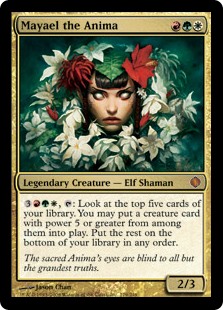
Of course, they can't go on printing an infinite number of Soulshift cards at ever-higher key numbers, and Body of Jukai is as high as they go. So reusing that will require a different approach. Don't actually sacrifice the nontoken Body of Jukai (and until that comes back on the initial run, give the same respect to the Thousand-Legged Kami). Instead, use Tel-Jilad Stylus to put it back in the deck, and then play Mayael the Anima. Activate her to look at the top five...er, one card, since that's all you have in the library right now, and...surprise! It's a creature with power 5 or greater, so plunk it straight back to the battlefield. You know what to do from here.
Activating Mayael costs 3RGW. Of course we have enough colorless mana to make even Emrakul drown, and by holding back on a single copy of Taiga during section 9, getting spare red and green mana isn't a problem. But nothing is capable of producing white mana yet, so this will have to wait a bit at first. Remember, only three lands in the deck: an Island, a Mountain Forest, and a land that doesn't produce any mana at all. Something has to give.
Section 12 Summary
Input: Mayael the Anima and a white mana (plus red and green, which are in plentiful supply from before)
Output: Lots of playings of Body of Jukai
Layer count: For each Rings of Brighthearth...1. Total 58.
Newly carved out space: Creatures with power 5 or greater.
Section 13
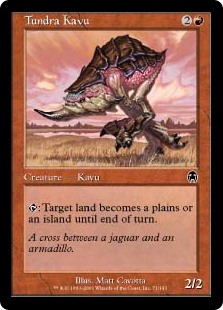
That something is Tundra Kavu, the junk-box common that somehow keeps on giving gifts. When you get to this point, leave a token copy of Snow-Covered Island untapped, and with its final, fresh batch of +1/+1 counters from Juniper Order Ranger (you could also leave a Taiga copy untapped, but the basic land is better because then you only miss out on one instance of the layers up to section 6, rather than section 8).
Play Tundra Kavu and get some tokens of it. Flickering Mayael is actually pretty easy, since she's a white creature and can be bounced with Escape Routes, plus there's no shortage of blue mana up here. However, just getting more copies of Mayael isn't helpful unless you've just tapped the last one, since the bottleneck is white mana, not copies of the creature (otherwise section 12 would have contributed a lot more than 1 layer).
Tundra Kavu is responsible for the white mana. Tap it to turn the Snow-Covered Island into a Plains (Tundra Kavu overwrites types rather than adding to them, so the land doesn't actually become functionally identical to a Tundra...but coincidentally, as both cards' names would imply, it's still snow-covered for no particular reason). Or at least...it becomes a Plains after the topmost Rings of Brighthearth copy resolves. Each time you get back to Rings of Brighthearth triggers here, make sure to save another Island, and use Skull of Orm to top up on Mana Reflections again. Sinking Feeling lets you run each newly-formed Plains back into the ground to produce white mana, rather than blue, and that's the story of how you can get brightness (and Mayael activations) out of seemingly nothing at all. Of course, the Kavu can run themselves into the ground too. They tend to do that a lot, or so claims the Flametongue Kavu with a strange knack for arriving on an empty board.
Section 13 Summary
Input: One playing of Tundra Kavu
Output: Lots of white mana
Layer count: For each Minion Reflector, for each Doubling Season on Minion Reflector, for each Rings of Brighthearth on Tundra Kavu, for each Doubling Season on Juniper Order Ranger that triggered for Tundra Kavu, for each Rings of Brighthearth on Sinking Feeling while it's on Tundra Kavu, for each Mana Reflection on the mana ability, for each Rings of Brighthearth on Sinking Feeling while it's on the newly-turned Plains, for each Doubling Season on Juniper Order Ranger that just added counters to the Island before it became a Plains...8. Total 66.
Newly carved out space: Plains; islands; white mana sinks
Section 14
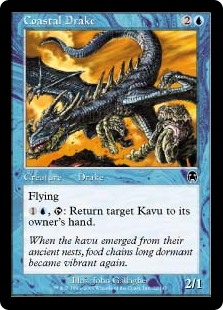
If there's one thing Tundra Kavu advertises about itself right in the name, it's that Tundra Kavu is a Kavu. (I guess it also tries to advertise that it's a Tundra, and I'd love to pull my copies out of the junk box and sell them to Star City for 70 bucks apiece, but the folks there don't seem to believe me. Maybe getting them to read this page, and gain awareness of what it can do, will change all that.)
You know who likes seeing Kavu around? Coastal Drake. Just play that, get some copies, and it's a straightforward bounce operation.
Funny thing: I noticed Coastal Drake early on while searching for cards that could bounce or reuse limited subsets of other cards, and passed over it as a complete joke; surely no Kavu were going to be useful in a combo like this. Then when my co-author found the sequence described in section 13 to give it a use after all, it stood out as probably the single most glaring instance of an imagination that finds the most oblique possibilities, and for finds such as that, I am eternally grateful.
Section 14 Summary
Input: One playing of Coastal Drake (and mana, which isn't scarce)
Output: Lots of playings of Tundra Kavu
Layer count: For each Minion Reflector, for each Doubling Season on Minion Reflector, for each Rings of Brighthearth on Coastal Drake, for each Doubling Season on Juniper Order Ranger, for each Rings of Brighthearth on Sinking Feeling...5. Total 71.
Newly carved out space: Kavu
Section 15


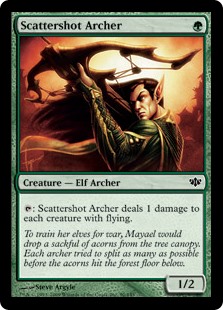
If there's one thing Coastal Drake advertises about itself right in the name, it's that Coastal Drake is a Drake. (And it comes from the Coast. Let me guess, it was probably made by some Wizards.) In Magic terms, that by itself isn't very useful: there's no such cross-type bouncer that works on Drakes. However, the thing about Drakes in Magic is they all fly (except for Mistform Ultimus and friends), and we can put that to use, although it will require some crazy tricks with the stack.
First off, play Leonin Shikari and Scythe of the Wretched, getting the obligatory copies of both. Right now they aren't very helpful: Opalescence has an exemption clause for Auras, but March of the Machines has no such thing: all artifacts, even Equipment, get animated. By rule, an Equipment creature is forcefully unattached (but at least it stays on the battlefield...a less gruesome fate than the Aura would suffer), and can't even begin to become attached in the first place.
Leave up a single 1/1 Skull of Orm from the section 1 loop, and play Scattershot Archer, complete with copies of that. Next, sacrifice every single copy of March of the Machines, so artifacts are no longer animated, and use up the last activation of the Skull, returning March of the Machines to your hand at some point among the copies on the ability (while the rest bring back and replay Doubling Season, as usual).
Equip a copy of Scythe of the Wretched to Scattershot Archer, then tap the Archer and get some Rings of Brighthearth copies. Each copy will deal 1 damage to each creature with flying, and there are two distinct creature cards with flying in the deck: Coastal Drake and Patron of the Moon (but it's non-targeted, so it hits all copies at the same time). Those creatures have picked up plenty of +1/+1 counters from Juniper Order Ranger, so 1 damage isn't nearly enough to kill, but you have a not-so-secret weapon: Ashnod's Altar, which allows you to sacrifice any creature for mana. Go ahead and do that with all the flyers. Patron of the Moon tokens won't be able to come back (and if section 14 is done correctly, there won't be any Coastal Drake tokens at this point), but both cards can, so Scythe of the Wretched triggers and brings back Patron, which is useless except for more sacrifice fodder, as well as Drake, which is the whole motivation behind this section. (Scythe will also attach to each of those creatures in turn, a pointless gesture.)
Anyway, with a brand new Drake for each burst of damage, this connects nicely to the previous section. Be sure to replay March of the Machines from hand before you get down the list to section 2 the first time, because you need that to allow Goblin Welder's ability to take advantage of Minion Reflector. Also, once you get done with all that repetition and the next thing that's about to resolve is another copy of the damage ability from Scattershot Archer, get rid of all the Marches of the Machines again so you can repeat the setup from the beginning of this section. Scythe needs to be equipped at the moment you sacrifice Coastal Drake, or else it won't trigger.
The fact that Scythe of the Wretched gives a toughness boost is dangerous, and almost fatal, because Goblin Welder can bring it back with an increasing number of copies, and those copies could be used to get even more untaps with Sinking Feeling before hitting the critical 0-toughness mark. However, in the end it works out safely. If you tried simply taking away March of the Machines and leaving it gone, not much would happen: Goblin Welder could bring a single copy in and out of the graveyard repeatedly, but the only way to make their ranks increase is if Minion Reflector gets to trigger, and it has to be a creature for that (so that means March has to stick around at least for some time). As soon as March arrives, all Equipment immediately detaches, and with it all the toughness boosts. The Scythe-bearer thus can't use such boosts to survive indefinitely and create larger boosts for itself, and nothing can create a self-contained loop this way. Good thing, too, because rewriting the whole procedure once new combo pieces are discovered, or found unacceptable, is by far the most tedious part of a process like this. I would know.
Section 15 Summary
Input: One playing of Scattershot Archer (plus Scythe of the Wretched and some delicate timing)
Output: Lots of playings of Coastal Drake
Layer count: For each Minion Reflector, for each Doubling Season on Minion Reflector, for each Rings of Brighthearth on Scattershot Archer, for each Doubling Season on Juniper Order Ranger, for each Rings of Brighthearth on Sinking Feeling...5. Total 76.
Newly carved out space: Creatures with flying; creatures with direct-damage abilities that can hit other creatures
Section 16
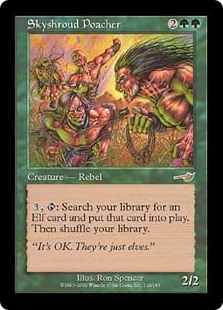
It doesn't really advertise it by name (in fact, the name almost sounds like it belongs on a red card), but Scattershot Archer is an Elf. That's nice, because Elves have tons of tribal support over the years.
Cue Skyshroud Poacher. This is similar to Moggcatcher way back in section 3, only it fetches Elves (obviously). Also, its own creature type happens to be Rebel (not Mercenary, and certainly not Elf), which is also good because now it can squeeze into the combo here, without being able to go infinite by having the Mercenary chain fetch it from out of their depth.
Just in case you were about to ask, no, we can't add a Rebel chain at this point. As anyone who played Mercadian Masques block constructed can attest, the Rebels search upward in converted mana cost, rather than downward like Mercenaries do. For example, Ramosian Sergeant costs 1 and fetches 2s (if you pay 3 for the privilege, and of course you also have the option of going lower than 2). Without exception, all the Rebels that search for each other are also capable of searching for other copies of themselves, and with no shortage of copies running around, we can't have that.
For the curious among you, Seahunter is the third member of the cycle, and as a Mercenary it can't coexist with Moggcatcher. If it had been a Rebel instead, maybe it could have been in business. But it's far too late to change that now.
Section 16 Summary
Input: One playing of Skyshroud Poacher
Output: Lots of playings of Scattershot Archer
Layer count: For each Minion Reflector, for each Doubling Season on Minion Reflector, for each Rings of Brighthearth on Skyshroud Poacher, for each Doubling Season on Juniper Order Ranger, for each Rings of Brighthearth on Sinking Feeling...5. Total 81.
Newly carved out space: Elves
Section 17
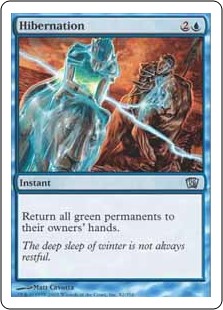
This is another spell section, so make sure to top up on Mirari again. Then play Hibernation, getting Mirari copies of it. All green permanents will be forcefully swept away, so sacrifice all the token green permanents first (might as well get some mana from them, since they won't be good for anything else) and then let a Hibernation resolve. Return Doubling Season, Groundskeeper, Mana Reflection, Nature's Revolt, Juniper Order Ranger, Body of Jukai (or, at first, Thousand-Legged Kami while it still has the acting-soulshifter-in-chief role), Mayael the Anima, Scattershot Archer, and Skyshroud Poacher all to your hand, then replay them, making sure to save the Poacher until everything else is done. There will be even more tokens to sacrifice before the next bout of Hibernation comes, but at least your permanents will wake up remarkably fast.
Remember, even though there are about 80 layers worth of Minion Reflector, and all the Doubling Seasons got swept away so you start over from 0, just playing that first one allows it to instantly catch up and pass the Minion Reflector count thanks to the magic of sticking "2^" in front of stuff, and then that number can serve as a starting point for all the other green permanents. (That is...after you finish paying for the triggers from all the Minion Reflectors. Like I said, the huge batch of floating mana is good for something.)
Section 17 Summary
Input: One playing of Hibernation
Output: Lots of playings of Skyshroud Poacher (and other green things)
Layer count: For each Mirari...1. Total 82.
Newly carved out space: Green permanents
Section 18
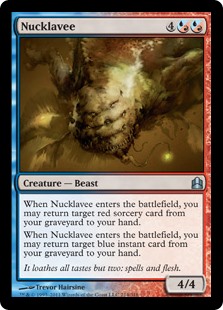
Unfortunately, this section is a bit wasteful. Play Nucklavee, getting its own two triggers and some Minion Reflector triggers. For best results here, you'll actually want to put the Nucklavee's own trigger on top. There are no red sorceries in the deck at all, so that ability can't return anything, and only one blue instant to return: Hibernation. Might as well.
Each time a Minion Reflector trigger resolves, you'll get a batch of tokens courtesy of Doubling Season. All the targets for all the abilities have to be chosen at the same time, so only one of them can successfully return Hibernation, while the rest will fizzle. If Nucklavee triggered on "dies" rather than "enters the battlefield", it would be more useful here, since then we could space the triggers out as necessary. But we can't, and it's the best we've got.
Section 18 Summary
Input: One playing of Nucklavee
Output: Lots of playings of Hibernation (but not as many as desired)
Layer count: For each Minion Reflector...1. Total 83.
Newly carved out space: Blue instants, red sorceries.
Section 19
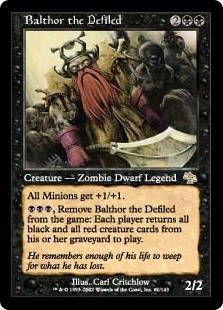
Play Balthor the Defiled. This time, immediately sacrifice it for mana, before getting the usual set of tokens. Mirror Gallery is mainly included because of Mirari, but Balthor can certainly take advantage of it too. The trick here is that you can activate a token copy of Balthor, and have it return the original, along with all other black and red creature cards (the mercenaries, the goblins, Tundra Kavu, and Nucklavee...of course, that last one occupies the highest layer so far, and it's the main motivation for having Balthor in the first place.) Each one will get even more copies from Minion Reflector.
Even though Balthor can use his copies from the Mirror Gallery to return himself, this doesn't go infinite either. Supply of Balthor copies isn't the bottleneck here; black mana is. And right now, we don't have any of it, so as with several other sections on the first trip through, you can come back to this later. (Anything this high that attempted to use a black creature as a bottleneck would be infinite already, due to Escape Routes way back when).
Balthor also has the curious ability "Minion creatures get +1/+1," a mirrored holdover ability from his original, living form. We don't actually have any Minion creatures in the deck, so this ability is as pointless as assembling Contraptions. (Though you could argue this whole deck is itself a giant contraption...) If there were actually any Minions higher up in the chain, they could go infinite by way of this ability and Sinking Feeling. Just saying.
Section 19 Summary
Input: Balthor the Defiled and three black mana
Output: Lots of playings of Nucklavee
Layer count: For each Rings of Brighthearth...1. Total 84.
Newly carved out space: Red creatures; Minions
Section 20
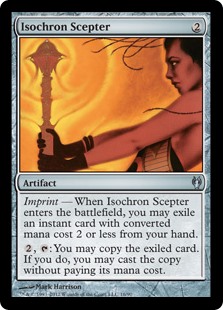
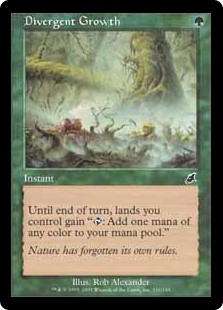
So far, Snow-Covered Island has been able to produce blue mana. Taiga could produce red or green. And Tundra Kavu could turn any land into a plains, capable of producing white. But black mana is the last color to get a use, if a suitable source could be found.
Play Isochron Scepter, imprinting nothing (since of course, the original doesn't get haste). Get some Minion Reflector tokens and imprint Divergent Growth on one of them; the rest have nothing to imprint and are purely sacrifice fodder.
Just like what happened with Tundra Kavu when it was time to make the donuts...I mean, the white mana, save a Snow-Covered Island (with all its counters--no, not those counters) when you get here, and top up on Mana Reflection. Activate Scepter with the power of Rings of Brighthearth, and since Scepter uses that magical word by telling you to cast the copy each time, you get to take advantage of Mirari too. Divergent Growth is not targeted; it applies to any lands you may have out, but you should only ever care about using it to get that single Snow-Covered Island to tap for any color, and in the case of Divergent Growth, that color should always be black. When you have a number this big, dividing it by 3 (since Balthor needs 3 mana for each single activation) causes absolutely no change in its representation, or at least the closest estimate thereof we can achieve in any reasonable space.
While yes, Goblin Welder can recycle artifacts including Isochron Scepter, this one is a very special case. Upon imprinting Divergent Growth, that card is forever lost to exile, and nothing else can ever reuse it. The imprint is tied to one particular copy of the Scepter (and not any other copy), which must be protected at all costs. If that copy ever leaves the battlefield, the imprint association is lost, with no way to reestablish it. That means no doing stuff like running Scepter into the ground with Sinking Feeling. Sure, it gets some counters from Juniper Order Ranger, but only one batch of triggers' worth upon entering the battlefield, and those are all it'll ever get. Using those counters will provide a "small" number of additional activations (for a very confused definition of "small"), but they don't parlay at all into any subsequent sections so they have no appreciable effect on the final total.
Also, lucky for us that Divergent Growth merely allows lands to tap for any color, instead of giving them "every basic land type" or even a basic land type of our choice, like Jinx. If it did that, then turning lands into mountains would create an upward branch and an infinite loop by being able to sweep them all up with Barrel Down Sokenzan. Especially at these high levels, there are a ton of pitfalls to watch out for.
Section 20 Summary
Input: One tap of the lucky Isochron Scepter
Output: Lots of black mana
Layer count: For each Rings of Brighthearth on Isochron Scepter, for each Mirari, for each Mana Reflection on the mana ability, for each Rings of Brighthearth on Sinking Feeling while it's attached to the land, for each Doubling Season on Juniper Order Ranger that just added counters to the land...5. Total 89.
Newly carved out space: Instants with converted mana cost 2 or less
Section 21
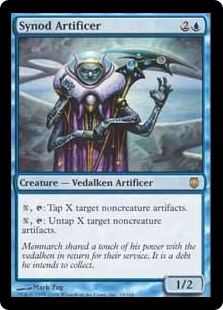
Play Synod Artificer, get tokens...what else is new? Given the targeting restriction, at this point you have to get rid of all copies of March of the Machines for a brief while, just like what happened in section 15 to handle Scythe of the Wretched.
When that's all done and Isochron Scepter has returned to its natural, blissful state of being a noncreature artifact, activate the Artificer's untap ability with X=1, targeting only Scepter, and all copies from Rings of Brighthearth will do the same.
Even though Scepter will certainly change back and forth, being a creature or not, countless times while you play through the prior sections, the machines should always stop marching by the time the next copy of the ability is created and resolves. Hence Scepter will be a legal target at the times when it actually matters.
Section 21 Summary
Input: One playing of Synod Artificer
Output: Lots of untaps of Isochron Scepter
Layer count: For each Minion Reflector, for each Doubling Season on Minion Reflector, for each Rings of Brighthearth on Synod Artificer, for each Doubling Season on Juniper Order Ranger, for each Rings of Brighthearth on Sinking Feeling...5. Total 94.
Newly carved out space: Tapping (or untapping) artifacts
Section 22
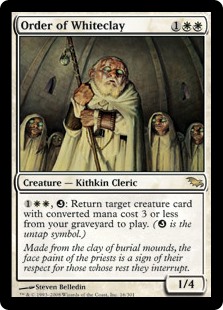
Sacrifice the nontoken Synod Artificer after (or before...it doesn't really matter) all the tokens have worked themselves to death, because it's better off dead. Next, play Order of Whiteclay, and use one of its tokens to start bringing back Synod Artificer. (Multiple copies of the Order actually end up redundant based on how subsequent sections play out; like so many other cards we've encountered, at least they can be sacrificed for some mana.)
Order of Whiteclay, as the name implies, is white, thus it can be returned by Escape Routes. It also has that magical mana cost of 3 on its own, so a copy of the ability can be used to have it return itself. Divergent Growth is several layers below this, and Tundra Kavu even lower, so clearly white mana production isn't a problem. No, the bottleneck here is (what else?) the Q, or untap, symbol. The tokens have haste and are thus free to attack once and tap that way, but we're not ready to advance to the combat phase, and there's no point in performing any loops after locking in a set of attacking creatures. So these can't tap (and can't untap either) just yet. But once they can...
Section 22 Summary
Input: One untap to Order of Whiteclay
Output: Lots of playings of Synod Artificer
Layer count: For each Rings of Brighthearth...1. Total 95.
Newly carved out space: Creatures with converted mana cost 3 or less
Section 23
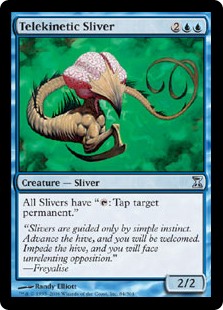
At this point, we've cast out bottlenecks on artifacts, enchantments, mana of any color, white creatures, black creatures, red creatures, green permanents of any kind, creatures with converted mana cost 3 or less, creatures with power 5 or more (so much for a chance to work Eldrazi in), and several other things. What does that leave? Well, lands...sure. But there's still some room before we get to that one. Notably, blue creature cards that cost 4 or more (and that have power 4 or less, and don't have one of a select few creature types) can still be stacked above everything without tripping the infinite alarm. And since the next cog in the system requires having a way to tap Order of Whiteclay, wouldn't you know it...
Play Telekinetic Sliver. (Sand Squid also serves an identical purpose, but the Sliver is more likely to be an extensible piece with help from future sets, so it's what I use in the list.) Get some tokens, and each of them has about a bazillion instances of the ability "T: Tap target permanent." Sure, only one instance actually matters, but it's funny to think about. With each copy of the ability, pick an Order of Whiteclay, any Order of Whiteclay...did you pick the Three of Clubs? Of course not; I count at least seven kithkin in the art, and only one staff, which doesn't look anything like a club. But anyway, whichever copy you chose...tap it. So you can untap it right away, unless you absent-mindedly chose the one that doesn't have haste. If you've read this far in, I'm sure you know how it works.
If there's one thing Slivers have in spades (or clubs for that matter), it's tribal support. Unfortunately, all the cards that came before this carved out so much space that nothing that keys off Slivers can safely be placed above this...truly, we're close to the end of the line. The most promising near-misses are Homing Sliver (which can be returned by Balthor, to go infinite without even touching the cycling ability) and Vedalken AEthermage (which can be returned by Order of Whiteclay). Still, the AEthermage would qualify if only it were slightly bigger, such as a 2/4 for 4, and Mark Rosewater himself claims that Slivers will almost certainly be back in the future, so there's definitely some design space that could help extend the combo in this gap. It just hasn't been given the good graces to appear on a card yet.
Section 23 Summary
Input: One playing of Telekinetic Sliver
Output: Lots of taps to Order of Whiteclay
Layer count: For each Minion Reflector, for each Doubling Season on Minion Reflector, for each Rings of Brighthearth on Telekinetic Sliver, for each Doubling Season on Juniper Order Ranger, for each Rings of Brighthearth on Sinking Feeling...5. Total 100.
Newly carved out space: Untap costs
Section 24
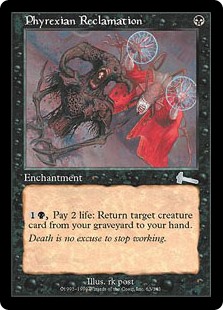
So Telekinetic Sliver looks to be the topmost permanent we can put a bottleneck on, other than lands. But there are still a few card slots left, and a few tricks up my sleeve.
Play Phyrexian Reclamation. Sacrifice Telekinetic Sliver; like Synod Artificer and many other cards before, the nontoken copy is better off dead. Activate Phyrexian Reclamation, and the first time through, the original activation targets Body of Jukai (so this is finally when it gets to come back after being used to kickstart the setup). Of course, all copies of the ability will target Telekinetic Sliver, and proceed as usual.
All colors of mana (even black) are plentiful at this point, so paying the 1B cost isn't a problem. Activating Phyrexian Reclamation also costs life, though, and as the meme goes...you only live twenty times. Something like that. Unless you gain more life, of course, and there hasn't been anything of the sort yet. So for now, you can activate Reclamation nine times without committing suicide, plus all the copies from Rings of Brighthearth.
Section 24 Summary
Input: 2 life (and some pocket change in the form of mana)
Output: Lots of playings of Telekinetic Sliver
Layer count: For each Rings of Brighthearth...1. Total 101.
Newly carved out space: Creature cards
Section 25


Okay, now it's time to bring lands into the picture, and since we basically can't use anything to do with mana, here's a novel idea: we won't.
Play Boon Reflection, which will be topped up. Then use Patron of the Moon to drop the third and final land, Diamond Valley. Get some Valley tokens, then activate one by sacrificing any dummy creature. That creature will have lots of +1/+1 counters from Juniper Order Ranger, undoubtedly, but the size is locked in during cost payment, and the effects from life gain will lead to vast increases in the number of Boon Reflections (among other things), so Boon Reflection will dominate the original creature size in setting the behavior of each life gain effect that resolves.
Lots of life means lots of opportunities to use Phyrexian Reclamation...so eventually you go back down to 2 again. Never change.
Section 25 Summary
Input: One playing of Diamond Valley
Output: Lots of life gain
Layer count: For each Minion Reflector, for each Doubling Season on Minion Reflector, for each Rings of Brighthearth on Diamond Valley, for each Boon Reflection on the lifegain, for each Doubling Season on Juniper Order Ranger, for each Rings of Brighthearth on Sinking Feeling...6. Total 107.
Newly carved out space: Life sinks
Section 26
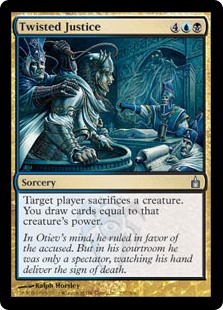
By my count, there have been 57 cards accounted for, so not much room for anything else. Now with nothing better to do, it's finally time to reveal the purpose of the particular setup routine we chose: because some cards can be put to double duty! Indeed, all this time, through sections 1-25, there have been several thousand objects sitting at the bottom of the stack: Reborn Hope (which doesn't have a legal target) at the very bottom, then 4096 Mirari triggers on it, then Twisted Justice, and 4095 Mirari triggers on that. Indeed, if you have a problem (of running out of both life and usable permanents), if no one else can help, and if you can find it under that messy, messy stack, you can use Twisted Justice as the next card.
Before Twisted Justice can resolve, surely you have lots of spare copies of Tel-Jilad Stylus lying around. Use them to stick the following permanents back in the deck (only the nontoken versions): Doubling Season, Minion Reflector, Rings of Brighthearth, Mirari, Mana Reflection, Boon Reflection, Juniper Order Ranger, Skull of Orm, Goblin Welder, Moggcatcher, Cateran Enforcer, Cateran Slaver, Cateran Overlord, Snow-Covered Island, Taiga, Body of Jukai, Tundra Kavu, Coastal Drake, Scattershot Archer, Skyshroud Poacher, Nucklavee, Synod Artificer, Telekinetic Sliver, and most importantly Diamond Valley--a total of 24 cards.
When you get to the final Section 1 loop before that happens, of course, stop short at the end when the last Skull of Orm token is still 24/24, and that's what you'll sacrifice to Twisted Justice, drawing all the cards that went back in the deck so you can replay them. Go back, explore all the previous sections top to bottom, then bottom to top again, and think of all the nice memories.
Section 26 Summary
Input: One playing of Twisted Justice
Output: Lots of playings of Diamond Valley and other permanents
Layer count: For each Mirari...1. Total 108.
Newly carved out space: Permanents
Section 27
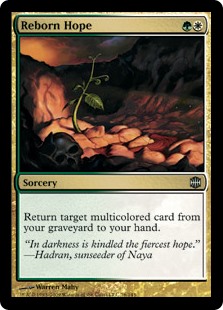
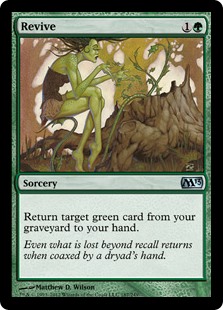
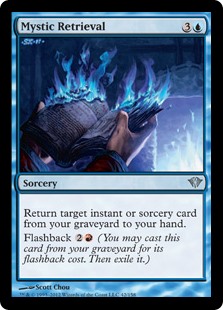
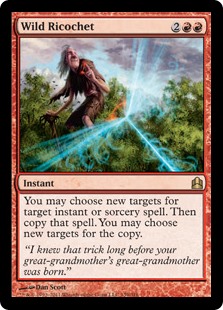
Below all the Twisted Justice on the stack is something slightly less twisted: Reborn Hope. Of course, that hope may be somewhat dimmed when each copy of it is just used to return Twisted Justice again, now worth a lot more than 4097 copies from Mirari. Everything from here on out is a spell step, so Mirari will need to be topped up just before each casting for best results.
Eventually, the mere thousands of Reborn Hope copies will run out too. Because Reborn Hope was also used during setup, the two most recent cards to cap the combo haven't cost any new slots, so there are still 3 of those left. Time for a last hurrah.
You can reuse Reborn Hope by playing Revive (and, obviously, Reborn Hope can't return Revive, otherwise it would be infinite). Revive, in turn, can be returned by Mystic Retrieval, which is neither green nor multicolored (despite what its flashback cost may lead you to believe). Copies of Mystic Retrieval can return any instant or sorcery card, including (theoretically) itself, but due to the way Mirari works, the original Mystic Retrieval will still be on the stack, below each of its copies, and the self-return issue...isn't actually an issue, since we have no counterspells that could cause the original Retrieval to leave the stack prematurely.
(Speaking of counterspells, Remand is fascinating as a counterspell which could theoretically be safe even in the midst of a combo section such as this one. It won't work in this particular deck--Tel-Jilad Stylus blows that idea out of the water by allowing the library to be replenished without limit--but it came up as a possible source of recursion in earlier brainstorming when there were actually spare card slots to fill.)
Anyway, Revive and Mystic Retrieval makes 59. For the last card slot, Mystic Retrieval is going to be repurposed. It won't actually bring back Revive. Instead, respond to it by playing Wild Ricochet (not Fork or Reverberate, because those are small enough to fit on Isochron Scepter, and certainly not Reiterate). Each copy of Wild Ricochet will make a copy of Mystic Retrieval, and that returns Revive each time, but when it's all done and the original Ricochet has resolved and gone to the graveyard, the next copy of Mystic Retrieval will be able to return Wild Ricochet, and repeat.
Eventually the Mirari triggers will all run out, and the original Mystic Retrieval resolves (actually no, it fizzles) and goes off to the graveyard like so many brave and honorable cards before it. After that...well, it has flashback, which you'll actually have to pay for with 2R of your own hard-earned mana (Omniscience only applies to cards you play from hand, not flashback or other unusual casting sources). One last gasp, complete with Mirari copies, which each bring back Wild Ricochet, and so on.
But after that...nothing. We're out of cards, and finally at the end of the line.
Section 27 Summary
Input: Mystic Retrieval, copied by Wild Ricochet
Output: More and more playings of Revive, Reborn Hope, and Twisted Justice in turn
Layer count: For each Mirari (repeated 4 times), for each casting of Mystic Retrieval...wait, that last one is just the number 2, so don't count it yet and say...4. Total 112 (not including flashback).
Newly carved out space: Instants and sorceries
Endgame

(This card is not actually included. Only the sentiment.)
These numbers are big enough that they defy description by any means other than boring, rote expressions (which are even underestimated by a good deal). But finally, after going through all 60 cards, and somehow dodging penalties for Slow Play and Stalling in the process, everything that can be done, has been.
Except for one minor little thing. So far, the Scattershot Archers have caused a good deal of friendly fire to rain down on our own creatures, but other than that, there's been exactly 0 damage dealt over the course of the combo. Now we can finally move to the combat phase, and swing with a massive army of stuff: Doubling Seasons, Minion Reflectors, Miraris, even some bona fide creatures like Auratog and Groundskeeper. Juniper Order Ranger has been contributing +1/+1 counters to everything, which don't really make a visible difference since they can't be meaningfully distinguished from the number of Doubling Seasons (the most frequently-recurred permanent, with all those visits to Section 1).
So how much damage is that? If you've been keeping track along with me, you'll see that my count comes to 112 layers of recursion. That means we're looking at a number of the form 2^^^^^^^^